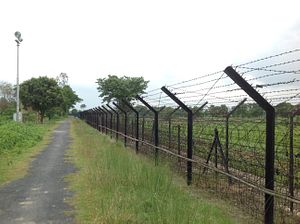When India’s parliament passed a historic land deal with Bangladesh on Thursday, a new chapter in bilateral relations between the two South Asian neighbors began. The deal will commence the arduous restructuring of India’s border with Bangladesh, resolving a decades-long source of tension and ushering in a new era of dynamism along South Asia’s eastern frontier.
The agreement will require India and Bangladesh to swap 162 enclaves in the border region: 111 that belong to India, and 51 that belong to Bangladesh. The swap honors the Land Boundary agreement of 1974, signed by India’s then-Prime Minister Indira Gandhi and Sheikh Mujibur Rahman, the founder of Bangladesh.
The Radcliffe Commission, the body given responsibility to redraw India’s border both at the eastern and western front in 1947, was the culprit for problems along the border. The hastily sketched border caused lots of confusion laying the foundation for future tensions. The new legislation corrects that mistake over six decades later.
That bill that the parliament passed was originally signed by former Prime Minister Manmohan Singh and Bangladesh’s current leader Sheikh Hasina, in 2011. The previous United Progressive Alliance (UPA) government led by Singh’s Congress Party could not muster enough support from the opposition, led by the Bharatiya Janata Party (BJP), to get the law ratified in parliament. The BJP deemed the bill an attack on India’s sovereignty.
On Thursday, the BJP, now in power, passed the bill without amendment.
Bangladesh has wholeheartedly welcomed the passage of the deal. The ruling Awami League, led by Hasina, has been attacked by her political opponents for the failure of the agreement in 2011, chastised for playing second fiddle to Delhi and disregarding Bangladesh’s sovereignty.
Thursday’s agreement will help bridge the divide that has emerged between the two countries over the past four years.
The only outstanding issue not resolved by the bill is the sharing of the water from the Teesta river, which forms the border between the Indian state of Sikkim and West Bengal. New Delhi has signed an agreement to resolve the issue, but local politicians in West Bengal have prevented implementation, holding out for a deal that will get Bangladesh more water during the dry season to till the land.
India’s former ambassador to Bangladesh, Humayun Kabir, thinks the deal will have a major impact. “This is a landmark development and has the potential to redefine the relationship between India and Bangladesh,” Kabir says. “The border deal will add momentum to trade relations and lead to greater trust between New Delhi and Dhaka.”
India shares a 4,000-kilometer border with Bangladesh, 90 percent of which lies in Northeast India. A stable and well-defined border will enable greater connectivity between the neighboring states. It will also prevent illegal immigration from Bangladesh, allowing India to complete the fencing of the border.
In India, Prime Minister Narendra Modi is likely to chalk up the deal as one of the signature achievements of his government so far. The opposition Congress can walk away satisfied too, knowing that the UPA government authored the bill in 2011.
With this ages-old border problem now resolved, Modi could have the momentum he needs to reach an understanding on the disputed Aksai Chin region when he visits China next week.

































